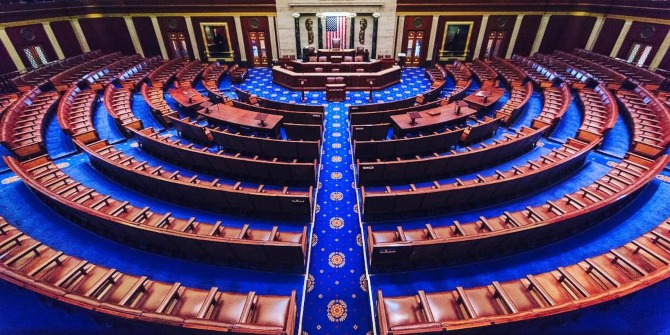In the second of three articles on political realignments, Walter Dean Burnham examines the “perfect” (and perfectly lethal) critical realignment of German politics and the rise of the Nazis from 1928 to 1933. He writes that the Nazis mostly drew their support from those who had voted for secular-liberal parties in the past and other non-voters. While some supporters of the Catholic Zentrum and the Marxist parties were essentially ‘immunized’ against voting for the Nazis, the crisis of the Great Depression meant that much of the remainder of the electorate were happy to support Adolf Hitler’s party.
The German political alignment that led to the rise of the Nazis and its world-historical consequences has generated a vast literature. The classic examination of the evolving composition of the Nazi electorate is Jürgen Falter’s, Hitlers Wähler, which is based upon a superbly comprehensive database (the Statistik des Deutschen Reichs from 1920-1933) and an effective regression analysis. My own contribution to this literature – probably the best work technically I ever did – is a summer 1972 article in The Journal of Interdisciplinary History. With desperate brevity, it can be summarized as follows:
A fundamental issue in analysis of electorates in democratic political systems is presented under conditions of very great stress. One take on this problematic is given in William H. Riker’s study, Liberalism Against Populism. A basic finding of this work is that no naturally occurring equilibria exist in politics. And so, Riker believed, it is politics, not economics, which is the true “dismal science.” (At least implicit in this view is that, when stress infects voters, they are capable of ‘going overboard’ toward proposed populist solutions to their problems en masse, without limit. He might well have used the 1854 Massachusetts stampede toward the just-erected Know-Nothing Party as an Exhibit A of his analysis.
My own take on the subject is based on examining where, if anywhere, in an electorate under stress resistances to the stampede can be found.
The late-Weimar German electoral dynamics of 1928-1932/3 classically reflect the existence of a contagion model; but the Nazified segments predominantly came from (a) former voters for secular-liberal parties and fragments of bourgeois interest groups and (b) people (i.e. nonvoters) who had dropped out of the ‘party of voters’ from 1920-1928. The German electorate had produced a multi-party system from the first Reichstag election in 1871 onwards, i.e. with nearly a half-century of experience and political socialization even before the shipwreck of the Weimar Republic unfolded.
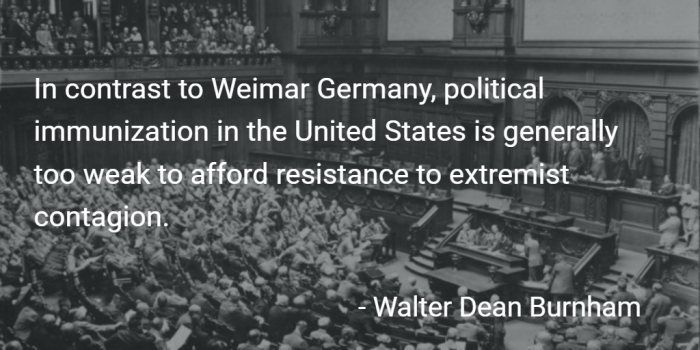
The resistance points against the post-1928 Nazi surge were quasi-total-“world-view’ voters for the Catholic minority’s Zentrum on one hand, and the two rival fragments of the Marxist left (SPD, Socialists) and KPD (communists). Needless to say, only about half of the Reich’s Catholic adults voted for the Zentrum, and only a fragment – around 40 to 50 percent of working-class voters – were adherents of the Marxist parties. Only those fragments were ‘confessionalized,” and more or less “immunized” from the surging impact of Nazi appeals as the great post-1928 Depression engulfed Germany. Outside of these groups, the Nazis found much support.
One statistical, time-dependent device is the so-called S or Logistic Curve, of this approximate shape. First created by Reed and Pearl of the Johns Hopkins Medical School around 1920, it was developed to deal with contagion situations: introduce a bacterium into a nutrient solution, reproduction follows very rapidly, until the solution’s carrying capacity is reached. Then die-off equals reproductive increase at limit k.
Figure 1 – S or Logistic Curve
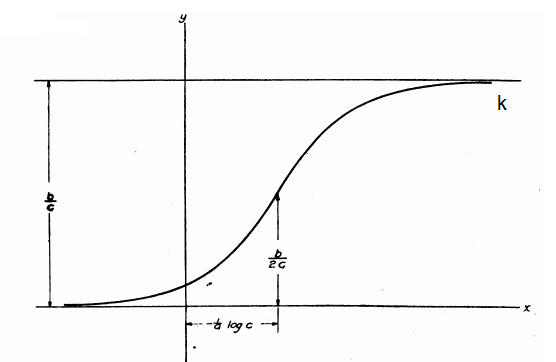
Source: http://math.bu.edu/people/mak/MA565/Pearl_Reed_PNAS_1920.pdf
In the Weimar case, the structure of the state was federalist, i.e. Landtag elections were held at various times for each of them between one Reichstag election and the next. The results of the votes are shown in Figure 2 below. The time intervals on the x-axis are thus only one-month long. The fit of the Nazi contagion, measured as percentages of the non-confessional – those who were not voting for Zentrum or the Communists – vote seems uncannily close by July 1932.
Figure 2 – Electoral Contagion in Germany, 1928-1933
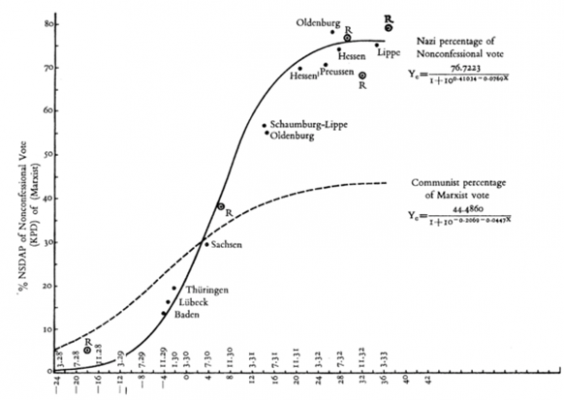
Some minor-civil-division data gets as close to the ultimate grass roots as we’re likely to get. As for Protestant-Catholic, we look at Oldenburg State, the northern part of which was solidly Protestant/Lutheran after 1648, and the southern was equally solidly Roman Catholic. We can see that in the Roman-Catholic south, Zentrum prevailed with nearly 90 percent of the vote. The north, on the other hand, lacking a ‘confessionalized’ bloc of voters voted largely for the Nazis.
Figure 3 – 1933 vote totals for North and South Oldenburg state
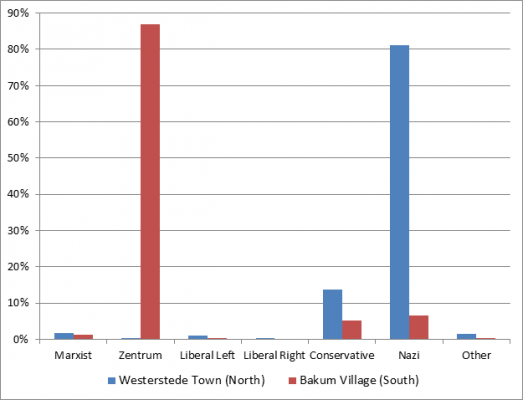
Turning back to the US in 1972, following Alabama Governor George C. Wallace’s third party presidential bid (which gained 13.5 percent of the vote), I wrote:
Where working-class people are not absorbed in political Socialism and the discrete Weltanschauung which goes with it, they will tend politically to behave like the European lower middle classes. That is, they will tend like their European petit bourgeois counterparts to support left-liberal parties in relatively tranquil periods. But they will also tend to be exceptionally receptive to extremist movements of the “radical center” when the pressure of crisis grows severe…the American working classes seem potentially the most vulnerable of all to capture under crisis pressure by a reflexive and authoritarian mass movement (p.16,17).
Sounds familiar? In contrast to Weimar Germany, political immunization in the United States is generally too weak to afford resistance to extremist contagion. This would certainly be consistent with Professor Riker’s fears.
Featured image credit: Bundesarchiv, N 1310 Bild-048 / CC-BY-SA 3.0 [CC BY-SA 3.0 de (http://creativecommons.org/licenses/by-sa/3.0/de/deed.en)], via Wikimedia Commons
Please read our comments policy before commenting.
Note: This article gives the views of the author, and not the position of USApp– American Politics and Policy, nor of the London School of Economics.
Shortened URL for this post: http://bit.ly/29pM92s
______________________

Walter Dean Burnham – University of Texas at Austin
Walter Dean Burnham is Professor Emeritus at the Department of Government at the University of Texas at Austin. Professor Burnham is best known for his work on the dynamics of American politics (particularly electoral politics). His chief areas of concentration have been on the causes, characteristics and consequences of critical realignments in American history, and the modern-day decay of partisan linkages between rulers and ruled. Much of his recent work has also concentrated on the “turnout problem” and its relationship to other elements of change in American politics. Before coming to Texas in 1988, he was Ruth and Arthur Sloan Professor of Political Science at Massachusetts Institute of Technology.





